Business Valuation of Vodafone Group Plc: Financial Management Report
VerifiedAdded on 2023/04/07
|16
|2968
|252
Report
AI Summary
This report presents a comprehensive business valuation of Vodafone Group Plc, evaluating its financial performance and market position. It begins with an introduction to business valuation, emphasizing its significance in investment decisions. The report delves into the methods of estimating the cost of capital, including the cost of debt, equity, and preference shares, with illustrative examples. It then applies these concepts to Vodafone, determining the cost of equity providers. The core of the report focuses on business valuation methods such as discounted cash flow (DCF), internal rate of return (IRR), and asset-based valuation, providing detailed calculations and analysis for Vodafone. The report also addresses foreign exchange issues related to the finance raised from bonds in different currencies. The analysis provides a practical application of financial management principles to assess Vodafone's value and investment potential, including its present value, internal rate of return, and net asset value, making it a valuable resource for students studying financial analysis and business valuation. The conclusion summarizes the findings and the report includes a detailed reference list.
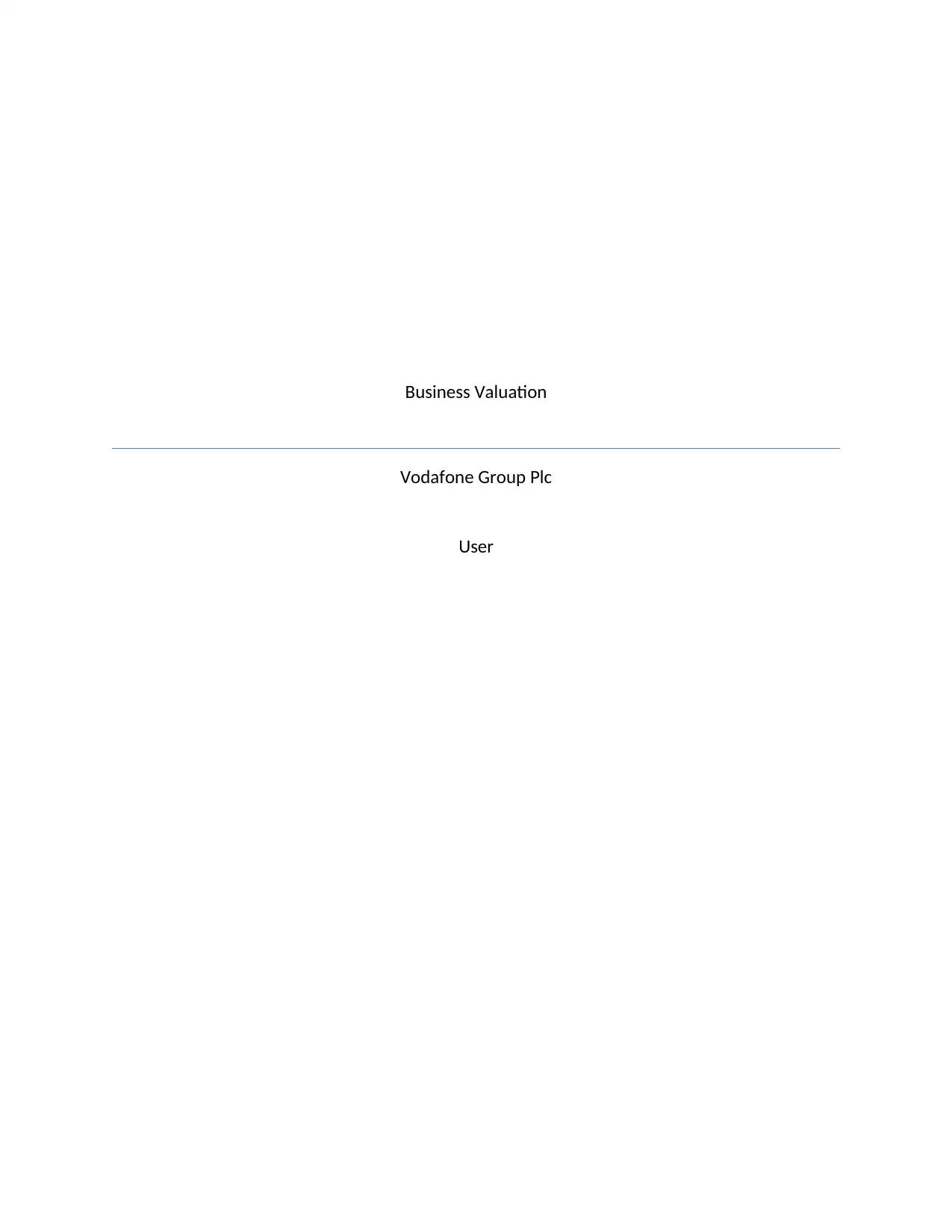
Business Valuation
Vodafone Group Plc
User
Vodafone Group Plc
User
Paraphrase This Document
Need a fresh take? Get an instant paraphrase of this document with our AI Paraphraser
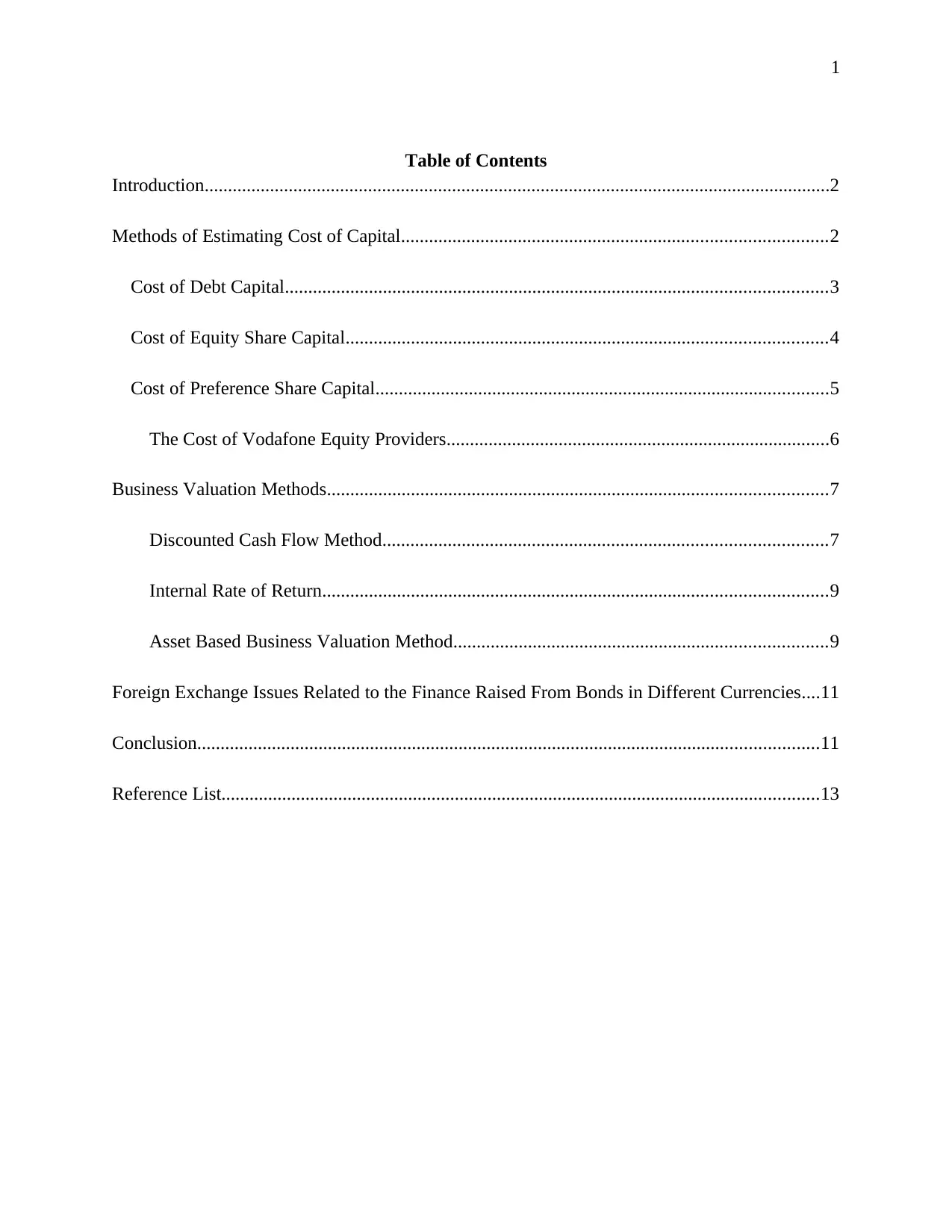
1
Table of Contents
Introduction......................................................................................................................................2
Methods of Estimating Cost of Capital...........................................................................................2
Cost of Debt Capital....................................................................................................................3
Cost of Equity Share Capital.......................................................................................................4
Cost of Preference Share Capital.................................................................................................5
The Cost of Vodafone Equity Providers..................................................................................6
Business Valuation Methods...........................................................................................................7
Discounted Cash Flow Method...............................................................................................7
Internal Rate of Return............................................................................................................9
Asset Based Business Valuation Method................................................................................9
Foreign Exchange Issues Related to the Finance Raised From Bonds in Different Currencies....11
Conclusion.....................................................................................................................................11
Reference List................................................................................................................................13
Table of Contents
Introduction......................................................................................................................................2
Methods of Estimating Cost of Capital...........................................................................................2
Cost of Debt Capital....................................................................................................................3
Cost of Equity Share Capital.......................................................................................................4
Cost of Preference Share Capital.................................................................................................5
The Cost of Vodafone Equity Providers..................................................................................6
Business Valuation Methods...........................................................................................................7
Discounted Cash Flow Method...............................................................................................7
Internal Rate of Return............................................................................................................9
Asset Based Business Valuation Method................................................................................9
Foreign Exchange Issues Related to the Finance Raised From Bonds in Different Currencies....11
Conclusion.....................................................................................................................................11
Reference List................................................................................................................................13
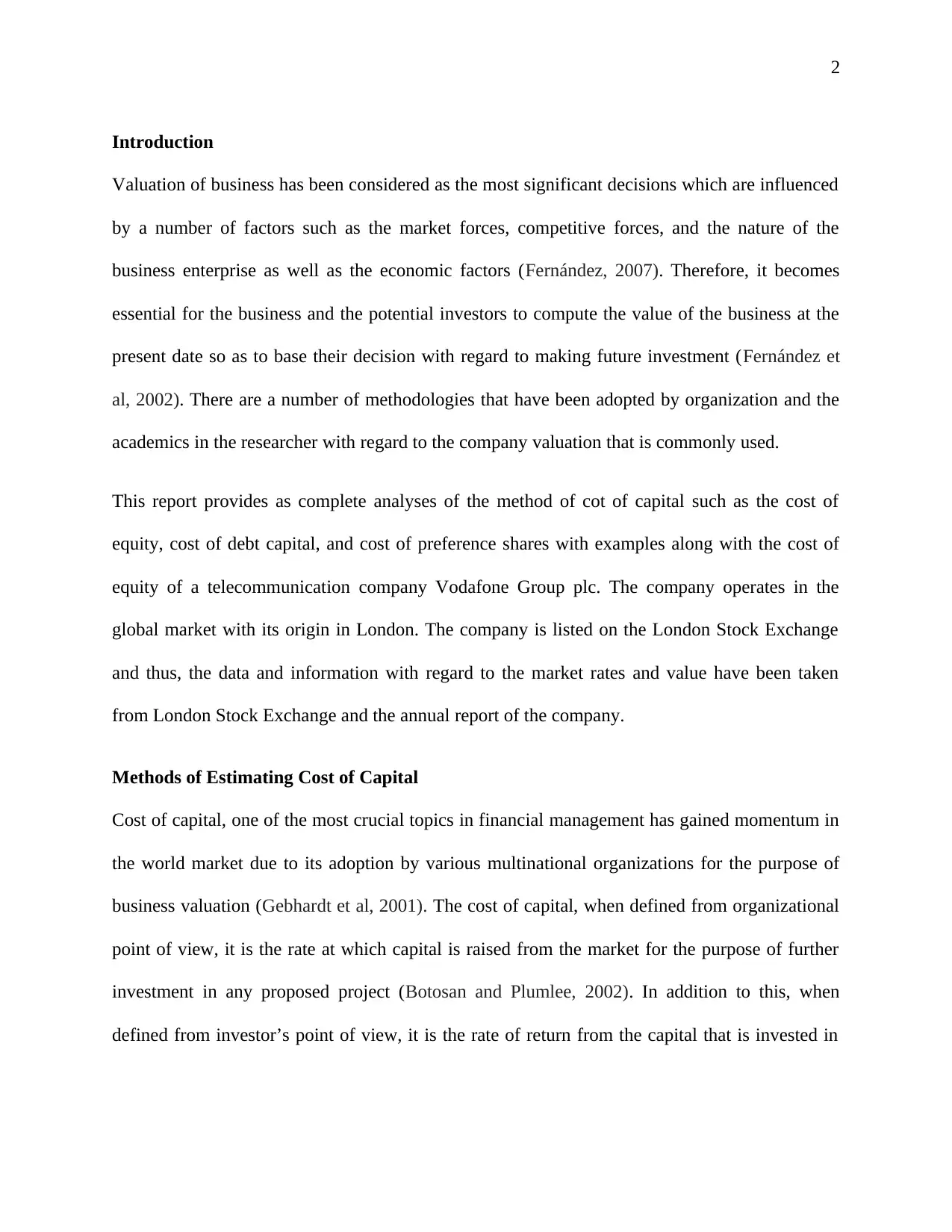
2
Introduction
Valuation of business has been considered as the most significant decisions which are influenced
by a number of factors such as the market forces, competitive forces, and the nature of the
business enterprise as well as the economic factors (Fernández, 2007). Therefore, it becomes
essential for the business and the potential investors to compute the value of the business at the
present date so as to base their decision with regard to making future investment (Fernández et
al, 2002). There are a number of methodologies that have been adopted by organization and the
academics in the researcher with regard to the company valuation that is commonly used.
This report provides as complete analyses of the method of cot of capital such as the cost of
equity, cost of debt capital, and cost of preference shares with examples along with the cost of
equity of a telecommunication company Vodafone Group plc. The company operates in the
global market with its origin in London. The company is listed on the London Stock Exchange
and thus, the data and information with regard to the market rates and value have been taken
from London Stock Exchange and the annual report of the company.
Methods of Estimating Cost of Capital
Cost of capital, one of the most crucial topics in financial management has gained momentum in
the world market due to its adoption by various multinational organizations for the purpose of
business valuation (Gebhardt et al, 2001). The cost of capital, when defined from organizational
point of view, it is the rate at which capital is raised from the market for the purpose of further
investment in any proposed project (Botosan and Plumlee, 2002). In addition to this, when
defined from investor’s point of view, it is the rate of return from the capital that is invested in
Introduction
Valuation of business has been considered as the most significant decisions which are influenced
by a number of factors such as the market forces, competitive forces, and the nature of the
business enterprise as well as the economic factors (Fernández, 2007). Therefore, it becomes
essential for the business and the potential investors to compute the value of the business at the
present date so as to base their decision with regard to making future investment (Fernández et
al, 2002). There are a number of methodologies that have been adopted by organization and the
academics in the researcher with regard to the company valuation that is commonly used.
This report provides as complete analyses of the method of cot of capital such as the cost of
equity, cost of debt capital, and cost of preference shares with examples along with the cost of
equity of a telecommunication company Vodafone Group plc. The company operates in the
global market with its origin in London. The company is listed on the London Stock Exchange
and thus, the data and information with regard to the market rates and value have been taken
from London Stock Exchange and the annual report of the company.
Methods of Estimating Cost of Capital
Cost of capital, one of the most crucial topics in financial management has gained momentum in
the world market due to its adoption by various multinational organizations for the purpose of
business valuation (Gebhardt et al, 2001). The cost of capital, when defined from organizational
point of view, it is the rate at which capital is raised from the market for the purpose of further
investment in any proposed project (Botosan and Plumlee, 2002). In addition to this, when
defined from investor’s point of view, it is the rate of return from the capital that is invested in
⊘ This is a preview!⊘
Do you want full access?
Subscribe today to unlock all pages.

Trusted by 1+ million students worldwide
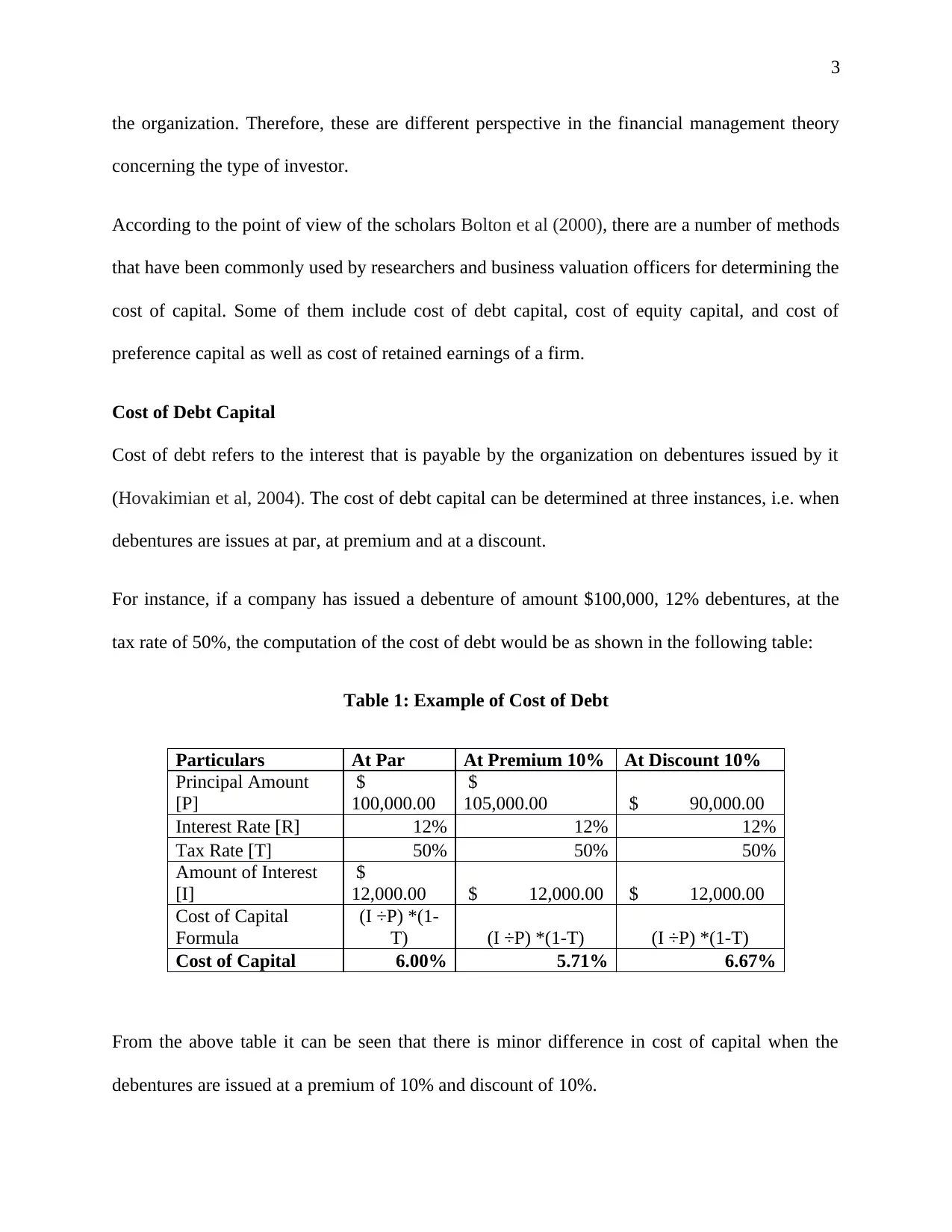
3
the organization. Therefore, these are different perspective in the financial management theory
concerning the type of investor.
According to the point of view of the scholars Bolton et al (2000), there are a number of methods
that have been commonly used by researchers and business valuation officers for determining the
cost of capital. Some of them include cost of debt capital, cost of equity capital, and cost of
preference capital as well as cost of retained earnings of a firm.
Cost of Debt Capital
Cost of debt refers to the interest that is payable by the organization on debentures issued by it
(Hovakimian et al, 2004). The cost of debt capital can be determined at three instances, i.e. when
debentures are issues at par, at premium and at a discount.
For instance, if a company has issued a debenture of amount $100,000, 12% debentures, at the
tax rate of 50%, the computation of the cost of debt would be as shown in the following table:
Table 1: Example of Cost of Debt
Particulars At Par At Premium 10% At Discount 10%
Principal Amount
[P]
$
100,000.00
$
105,000.00 $ 90,000.00
Interest Rate [R] 12% 12% 12%
Tax Rate [T] 50% 50% 50%
Amount of Interest
[I]
$
12,000.00 $ 12,000.00 $ 12,000.00
Cost of Capital
Formula
(I ÷P) *(1-
T) (I ÷P) *(1-T) (I ÷P) *(1-T)
Cost of Capital 6.00% 5.71% 6.67%
From the above table it can be seen that there is minor difference in cost of capital when the
debentures are issued at a premium of 10% and discount of 10%.
the organization. Therefore, these are different perspective in the financial management theory
concerning the type of investor.
According to the point of view of the scholars Bolton et al (2000), there are a number of methods
that have been commonly used by researchers and business valuation officers for determining the
cost of capital. Some of them include cost of debt capital, cost of equity capital, and cost of
preference capital as well as cost of retained earnings of a firm.
Cost of Debt Capital
Cost of debt refers to the interest that is payable by the organization on debentures issued by it
(Hovakimian et al, 2004). The cost of debt capital can be determined at three instances, i.e. when
debentures are issues at par, at premium and at a discount.
For instance, if a company has issued a debenture of amount $100,000, 12% debentures, at the
tax rate of 50%, the computation of the cost of debt would be as shown in the following table:
Table 1: Example of Cost of Debt
Particulars At Par At Premium 10% At Discount 10%
Principal Amount
[P]
$
100,000.00
$
105,000.00 $ 90,000.00
Interest Rate [R] 12% 12% 12%
Tax Rate [T] 50% 50% 50%
Amount of Interest
[I]
$
12,000.00 $ 12,000.00 $ 12,000.00
Cost of Capital
Formula
(I ÷P) *(1-
T) (I ÷P) *(1-T) (I ÷P) *(1-T)
Cost of Capital 6.00% 5.71% 6.67%
From the above table it can be seen that there is minor difference in cost of capital when the
debentures are issued at a premium of 10% and discount of 10%.
Paraphrase This Document
Need a fresh take? Get an instant paraphrase of this document with our AI Paraphraser
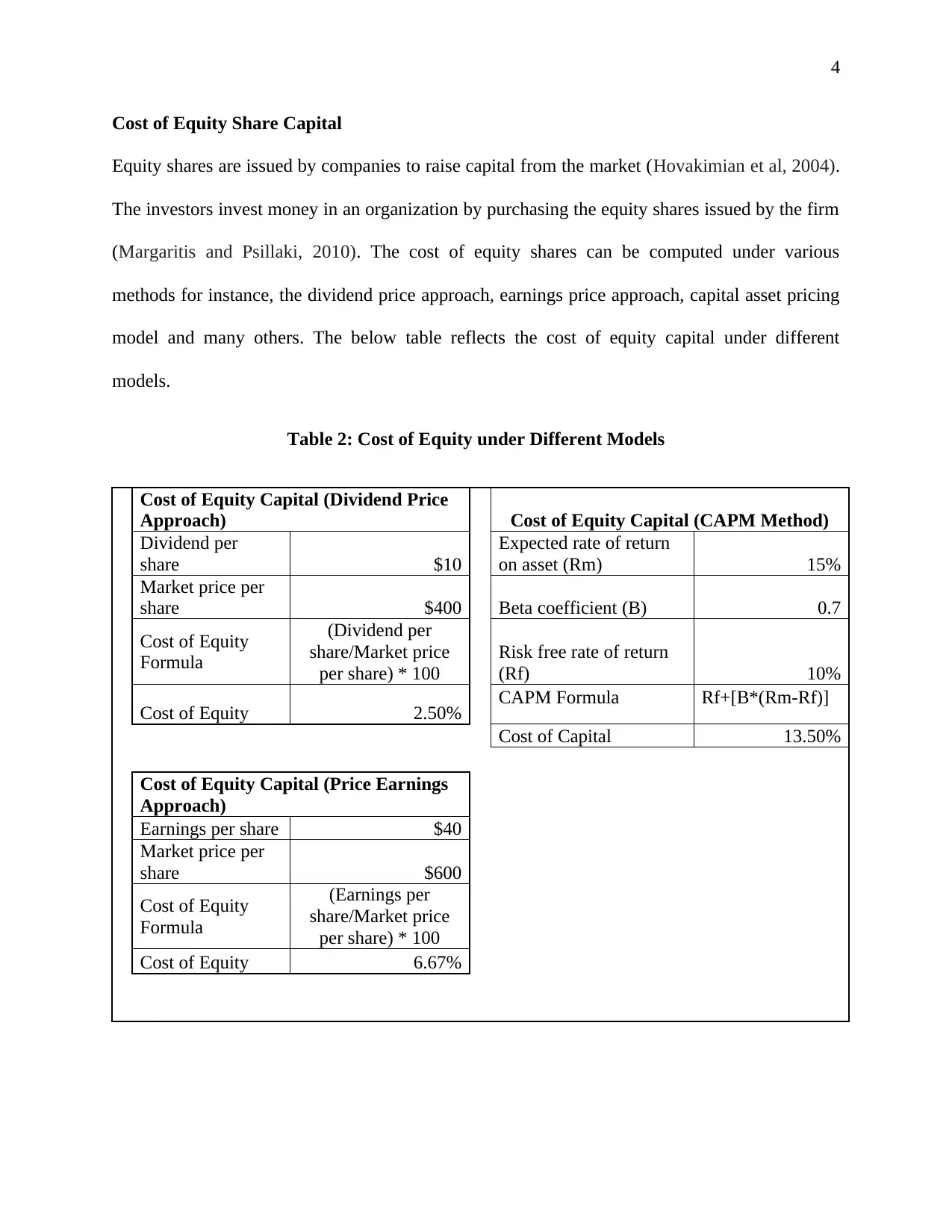
4
Cost of Equity Share Capital
Equity shares are issued by companies to raise capital from the market (Hovakimian et al, 2004).
The investors invest money in an organization by purchasing the equity shares issued by the firm
(Margaritis and Psillaki, 2010). The cost of equity shares can be computed under various
methods for instance, the dividend price approach, earnings price approach, capital asset pricing
model and many others. The below table reflects the cost of equity capital under different
models.
Table 2: Cost of Equity under Different Models
Cost of Equity Capital (Dividend Price
Approach) Cost of Equity Capital (CAPM Method)
Dividend per
share $10
Expected rate of return
on asset (Rm) 15%
Market price per
share $400 Beta coefficient (B) 0.7
Cost of Equity
Formula
(Dividend per
share/Market price
per share) * 100
Risk free rate of return
(Rf) 10%
Cost of Equity 2.50% CAPM Formula Rf+[B*(Rm-Rf)]
Cost of Capital 13.50%
Cost of Equity Capital (Price Earnings
Approach)
Earnings per share $40
Market price per
share $600
Cost of Equity
Formula
(Earnings per
share/Market price
per share) * 100
Cost of Equity 6.67%
Cost of Equity Share Capital
Equity shares are issued by companies to raise capital from the market (Hovakimian et al, 2004).
The investors invest money in an organization by purchasing the equity shares issued by the firm
(Margaritis and Psillaki, 2010). The cost of equity shares can be computed under various
methods for instance, the dividend price approach, earnings price approach, capital asset pricing
model and many others. The below table reflects the cost of equity capital under different
models.
Table 2: Cost of Equity under Different Models
Cost of Equity Capital (Dividend Price
Approach) Cost of Equity Capital (CAPM Method)
Dividend per
share $10
Expected rate of return
on asset (Rm) 15%
Market price per
share $400 Beta coefficient (B) 0.7
Cost of Equity
Formula
(Dividend per
share/Market price
per share) * 100
Risk free rate of return
(Rf) 10%
Cost of Equity 2.50% CAPM Formula Rf+[B*(Rm-Rf)]
Cost of Capital 13.50%
Cost of Equity Capital (Price Earnings
Approach)
Earnings per share $40
Market price per
share $600
Cost of Equity
Formula
(Earnings per
share/Market price
per share) * 100
Cost of Equity 6.67%
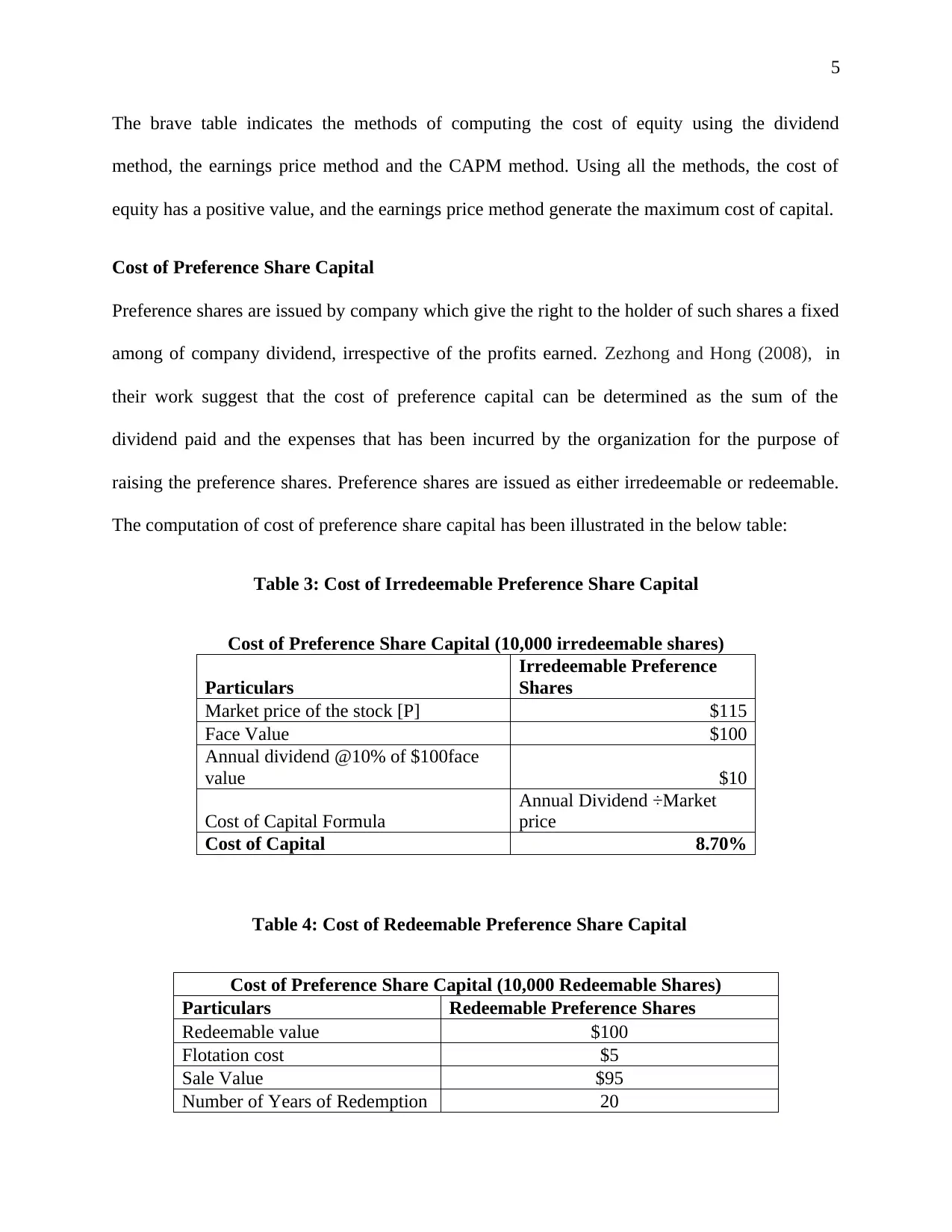
5
The brave table indicates the methods of computing the cost of equity using the dividend
method, the earnings price method and the CAPM method. Using all the methods, the cost of
equity has a positive value, and the earnings price method generate the maximum cost of capital.
Cost of Preference Share Capital
Preference shares are issued by company which give the right to the holder of such shares a fixed
among of company dividend, irrespective of the profits earned. Zezhong and Hong (2008), in
their work suggest that the cost of preference capital can be determined as the sum of the
dividend paid and the expenses that has been incurred by the organization for the purpose of
raising the preference shares. Preference shares are issued as either irredeemable or redeemable.
The computation of cost of preference share capital has been illustrated in the below table:
Table 3: Cost of Irredeemable Preference Share Capital
Cost of Preference Share Capital (10,000 irredeemable shares)
Particulars
Irredeemable Preference
Shares
Market price of the stock [P] $115
Face Value $100
Annual dividend @10% of $100face
value $10
Cost of Capital Formula
Annual Dividend ÷Market
price
Cost of Capital 8.70%
Table 4: Cost of Redeemable Preference Share Capital
Cost of Preference Share Capital (10,000 Redeemable Shares)
Particulars Redeemable Preference Shares
Redeemable value $100
Flotation cost $5
Sale Value $95
Number of Years of Redemption 20
The brave table indicates the methods of computing the cost of equity using the dividend
method, the earnings price method and the CAPM method. Using all the methods, the cost of
equity has a positive value, and the earnings price method generate the maximum cost of capital.
Cost of Preference Share Capital
Preference shares are issued by company which give the right to the holder of such shares a fixed
among of company dividend, irrespective of the profits earned. Zezhong and Hong (2008), in
their work suggest that the cost of preference capital can be determined as the sum of the
dividend paid and the expenses that has been incurred by the organization for the purpose of
raising the preference shares. Preference shares are issued as either irredeemable or redeemable.
The computation of cost of preference share capital has been illustrated in the below table:
Table 3: Cost of Irredeemable Preference Share Capital
Cost of Preference Share Capital (10,000 irredeemable shares)
Particulars
Irredeemable Preference
Shares
Market price of the stock [P] $115
Face Value $100
Annual dividend @10% of $100face
value $10
Cost of Capital Formula
Annual Dividend ÷Market
price
Cost of Capital 8.70%
Table 4: Cost of Redeemable Preference Share Capital
Cost of Preference Share Capital (10,000 Redeemable Shares)
Particulars Redeemable Preference Shares
Redeemable value $100
Flotation cost $5
Sale Value $95
Number of Years of Redemption 20
⊘ This is a preview!⊘
Do you want full access?
Subscribe today to unlock all pages.

Trusted by 1+ million students worldwide
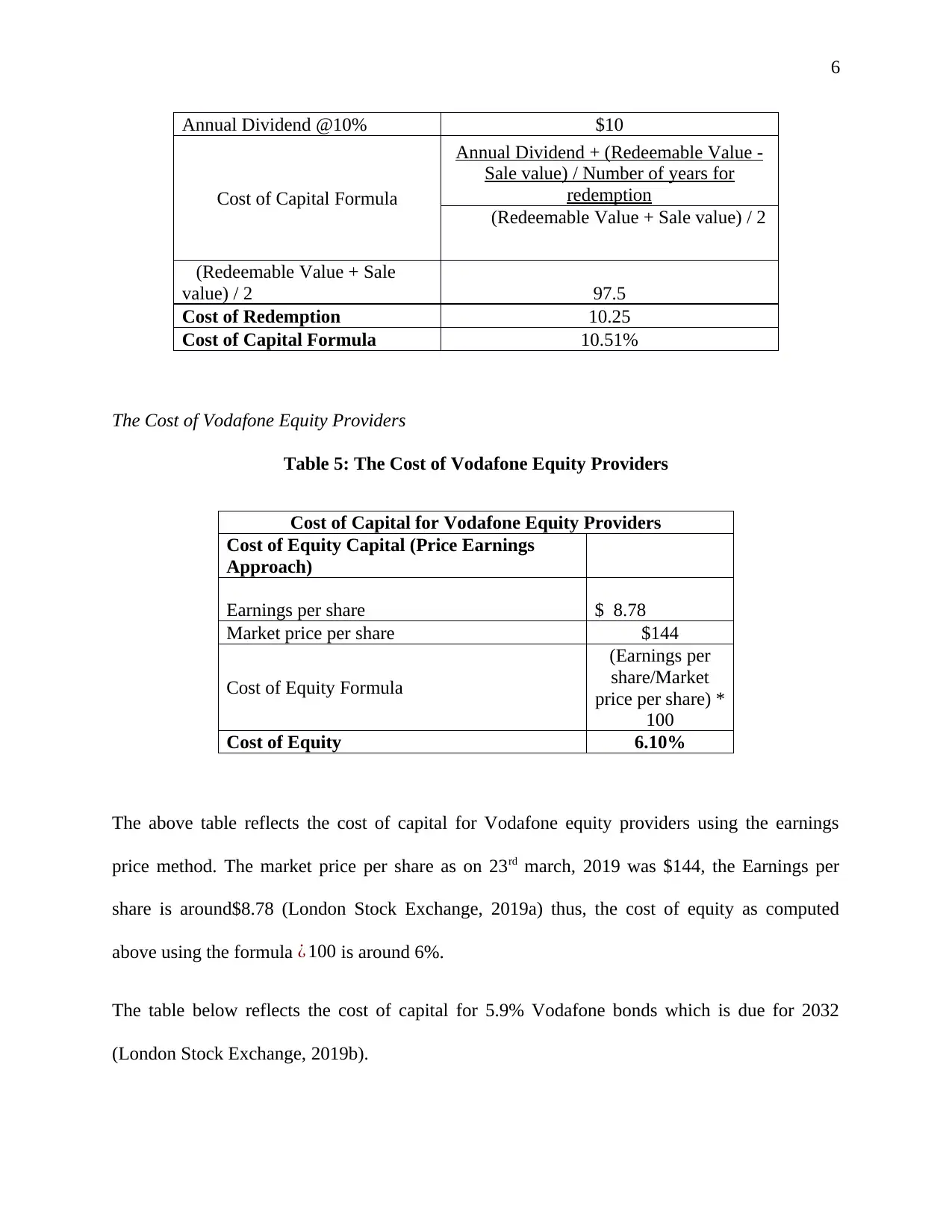
6
Annual Dividend @10% $10
Cost of Capital Formula
Annual Dividend + (Redeemable Value -
Sale value) / Number of years for
redemption
(Redeemable Value + Sale value) / 2
(Redeemable Value + Sale
value) / 2 97.5
Cost of Redemption 10.25
Cost of Capital Formula 10.51%
The Cost of Vodafone Equity Providers
Table 5: The Cost of Vodafone Equity Providers
Cost of Capital for Vodafone Equity Providers
Cost of Equity Capital (Price Earnings
Approach)
Earnings per share $ 8.78
Market price per share $144
Cost of Equity Formula
(Earnings per
share/Market
price per share) *
100
Cost of Equity 6.10%
The above table reflects the cost of capital for Vodafone equity providers using the earnings
price method. The market price per share as on 23rd march, 2019 was $144, the Earnings per
share is around$8.78 (London Stock Exchange, 2019a) thus, the cost of equity as computed
above using the formula ¿ 100 is around 6%.
The table below reflects the cost of capital for 5.9% Vodafone bonds which is due for 2032
(London Stock Exchange, 2019b).
Annual Dividend @10% $10
Cost of Capital Formula
Annual Dividend + (Redeemable Value -
Sale value) / Number of years for
redemption
(Redeemable Value + Sale value) / 2
(Redeemable Value + Sale
value) / 2 97.5
Cost of Redemption 10.25
Cost of Capital Formula 10.51%
The Cost of Vodafone Equity Providers
Table 5: The Cost of Vodafone Equity Providers
Cost of Capital for Vodafone Equity Providers
Cost of Equity Capital (Price Earnings
Approach)
Earnings per share $ 8.78
Market price per share $144
Cost of Equity Formula
(Earnings per
share/Market
price per share) *
100
Cost of Equity 6.10%
The above table reflects the cost of capital for Vodafone equity providers using the earnings
price method. The market price per share as on 23rd march, 2019 was $144, the Earnings per
share is around$8.78 (London Stock Exchange, 2019a) thus, the cost of equity as computed
above using the formula ¿ 100 is around 6%.
The table below reflects the cost of capital for 5.9% Vodafone bonds which is due for 2032
(London Stock Exchange, 2019b).
Paraphrase This Document
Need a fresh take? Get an instant paraphrase of this document with our AI Paraphraser
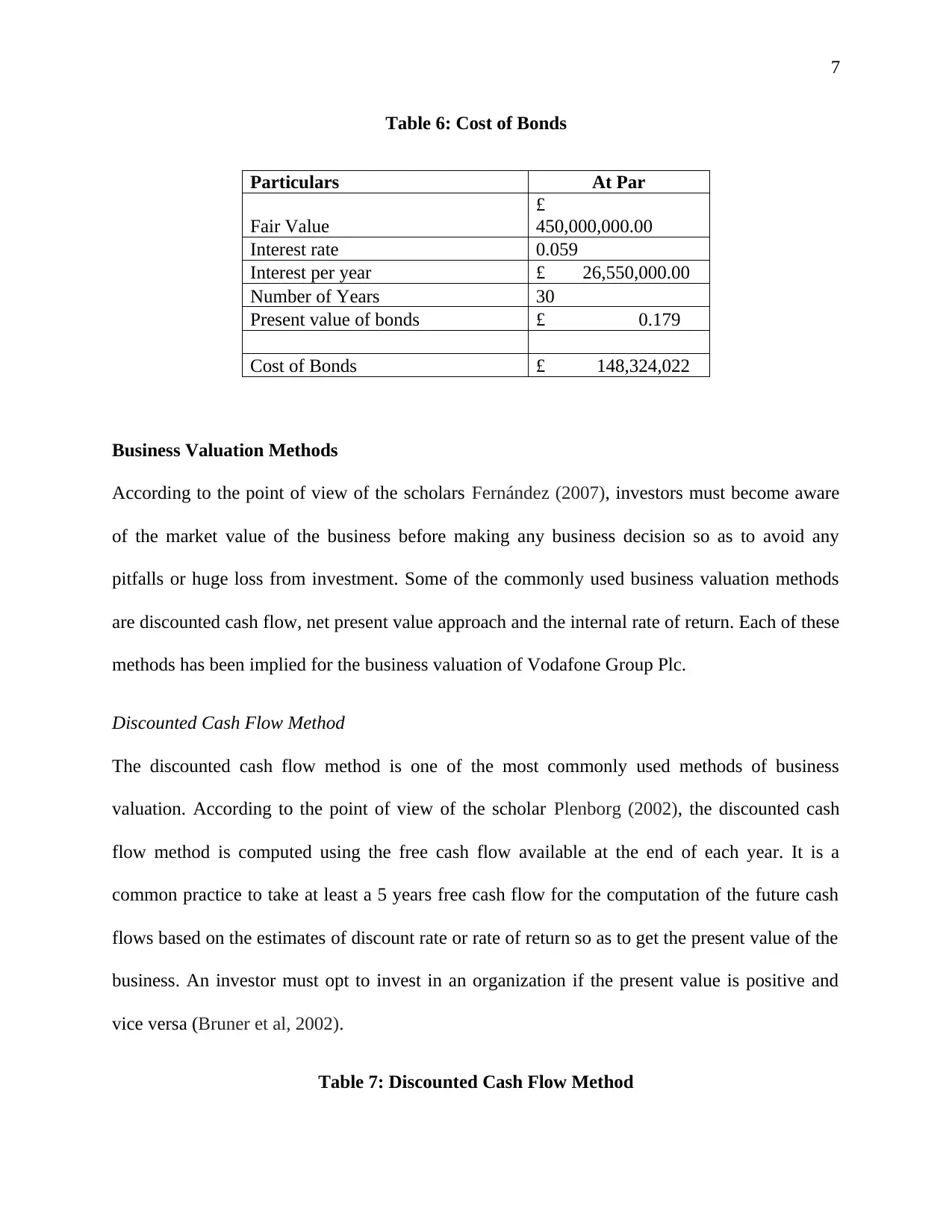
7
Table 6: Cost of Bonds
Particulars At Par
Fair Value
£
450,000,000.00
Interest rate 0.059
Interest per year £ 26,550,000.00
Number of Years 30
Present value of bonds £ 0.179
Cost of Bonds £ 148,324,022
Business Valuation Methods
According to the point of view of the scholars Fernández (2007), investors must become aware
of the market value of the business before making any business decision so as to avoid any
pitfalls or huge loss from investment. Some of the commonly used business valuation methods
are discounted cash flow, net present value approach and the internal rate of return. Each of these
methods has been implied for the business valuation of Vodafone Group Plc.
Discounted Cash Flow Method
The discounted cash flow method is one of the most commonly used methods of business
valuation. According to the point of view of the scholar Plenborg (2002), the discounted cash
flow method is computed using the free cash flow available at the end of each year. It is a
common practice to take at least a 5 years free cash flow for the computation of the future cash
flows based on the estimates of discount rate or rate of return so as to get the present value of the
business. An investor must opt to invest in an organization if the present value is positive and
vice versa (Bruner et al, 2002).
Table 7: Discounted Cash Flow Method
Table 6: Cost of Bonds
Particulars At Par
Fair Value
£
450,000,000.00
Interest rate 0.059
Interest per year £ 26,550,000.00
Number of Years 30
Present value of bonds £ 0.179
Cost of Bonds £ 148,324,022
Business Valuation Methods
According to the point of view of the scholars Fernández (2007), investors must become aware
of the market value of the business before making any business decision so as to avoid any
pitfalls or huge loss from investment. Some of the commonly used business valuation methods
are discounted cash flow, net present value approach and the internal rate of return. Each of these
methods has been implied for the business valuation of Vodafone Group Plc.
Discounted Cash Flow Method
The discounted cash flow method is one of the most commonly used methods of business
valuation. According to the point of view of the scholar Plenborg (2002), the discounted cash
flow method is computed using the free cash flow available at the end of each year. It is a
common practice to take at least a 5 years free cash flow for the computation of the future cash
flows based on the estimates of discount rate or rate of return so as to get the present value of the
business. An investor must opt to invest in an organization if the present value is positive and
vice versa (Bruner et al, 2002).
Table 7: Discounted Cash Flow Method
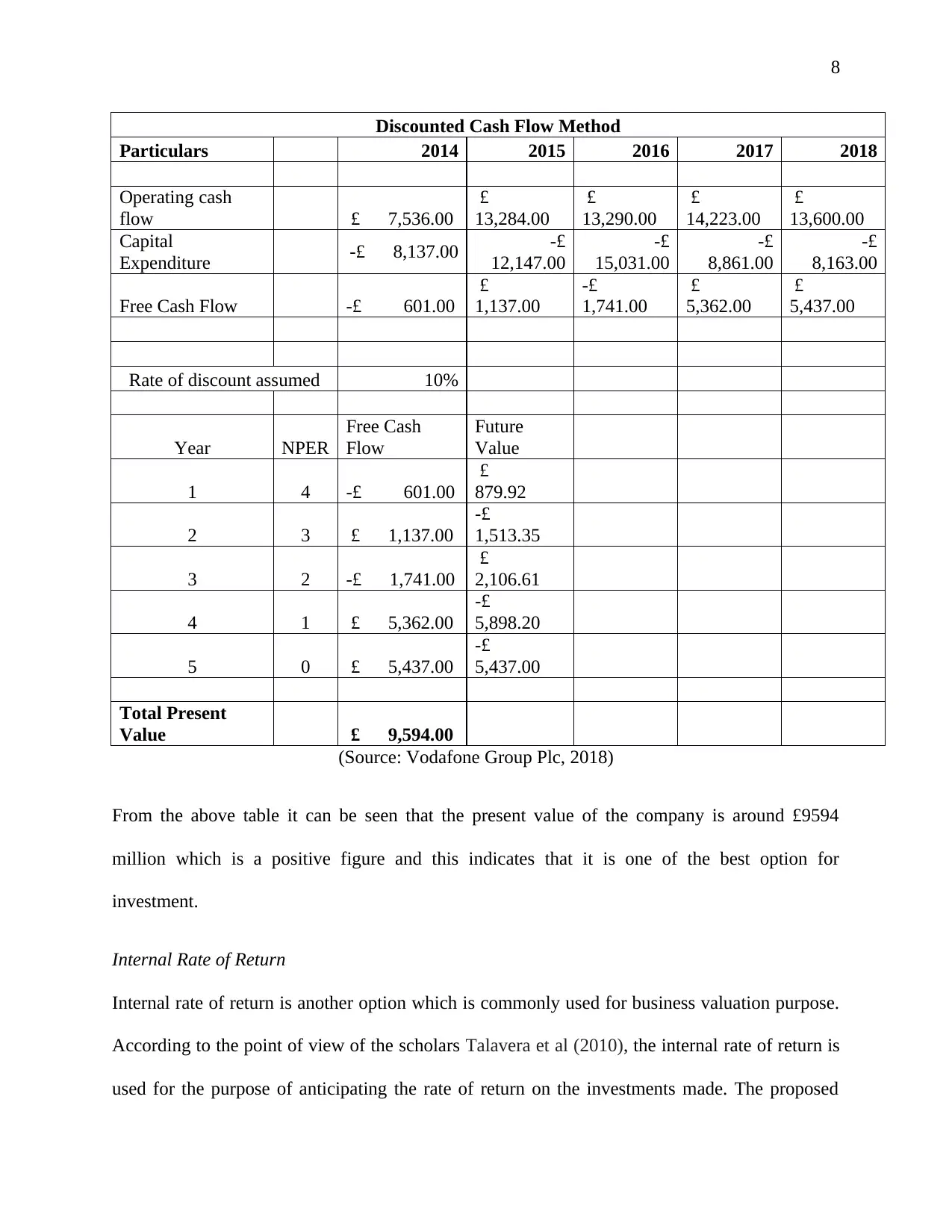
8
Discounted Cash Flow Method
Particulars 2014 2015 2016 2017 2018
Operating cash
flow £ 7,536.00
£
13,284.00
£
13,290.00
£
14,223.00
£
13,600.00
Capital
Expenditure -£ 8,137.00 -£
12,147.00
-£
15,031.00
-£
8,861.00
-£
8,163.00
Free Cash Flow -£ 601.00
£
1,137.00
-£
1,741.00
£
5,362.00
£
5,437.00
Rate of discount assumed 10%
Year NPER
Free Cash
Flow
Future
Value
1 4 -£ 601.00
£
879.92
2 3 £ 1,137.00
-£
1,513.35
3 2 -£ 1,741.00
£
2,106.61
4 1 £ 5,362.00
-£
5,898.20
5 0 £ 5,437.00
-£
5,437.00
Total Present
Value £ 9,594.00
(Source: Vodafone Group Plc, 2018)
From the above table it can be seen that the present value of the company is around £9594
million which is a positive figure and this indicates that it is one of the best option for
investment.
Internal Rate of Return
Internal rate of return is another option which is commonly used for business valuation purpose.
According to the point of view of the scholars Talavera et al (2010), the internal rate of return is
used for the purpose of anticipating the rate of return on the investments made. The proposed
Discounted Cash Flow Method
Particulars 2014 2015 2016 2017 2018
Operating cash
flow £ 7,536.00
£
13,284.00
£
13,290.00
£
14,223.00
£
13,600.00
Capital
Expenditure -£ 8,137.00 -£
12,147.00
-£
15,031.00
-£
8,861.00
-£
8,163.00
Free Cash Flow -£ 601.00
£
1,137.00
-£
1,741.00
£
5,362.00
£
5,437.00
Rate of discount assumed 10%
Year NPER
Free Cash
Flow
Future
Value
1 4 -£ 601.00
£
879.92
2 3 £ 1,137.00
-£
1,513.35
3 2 -£ 1,741.00
£
2,106.61
4 1 £ 5,362.00
-£
5,898.20
5 0 £ 5,437.00
-£
5,437.00
Total Present
Value £ 9,594.00
(Source: Vodafone Group Plc, 2018)
From the above table it can be seen that the present value of the company is around £9594
million which is a positive figure and this indicates that it is one of the best option for
investment.
Internal Rate of Return
Internal rate of return is another option which is commonly used for business valuation purpose.
According to the point of view of the scholars Talavera et al (2010), the internal rate of return is
used for the purpose of anticipating the rate of return on the investments made. The proposed
⊘ This is a preview!⊘
Do you want full access?
Subscribe today to unlock all pages.

Trusted by 1+ million students worldwide
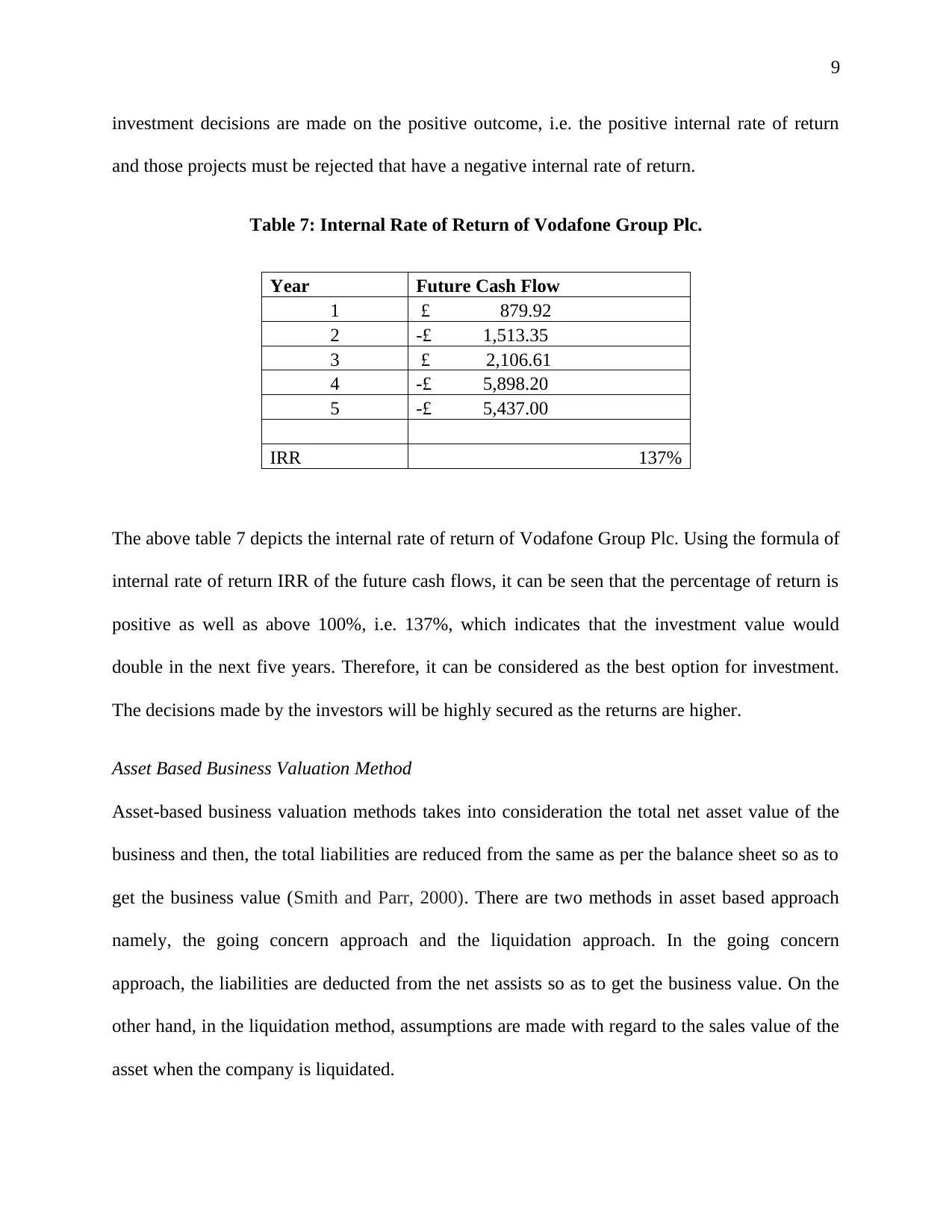
9
investment decisions are made on the positive outcome, i.e. the positive internal rate of return
and those projects must be rejected that have a negative internal rate of return.
Table 7: Internal Rate of Return of Vodafone Group Plc.
Year Future Cash Flow
1 £ 879.92
2 -£ 1,513.35
3 £ 2,106.61
4 -£ 5,898.20
5 -£ 5,437.00
IRR 137%
The above table 7 depicts the internal rate of return of Vodafone Group Plc. Using the formula of
internal rate of return IRR of the future cash flows, it can be seen that the percentage of return is
positive as well as above 100%, i.e. 137%, which indicates that the investment value would
double in the next five years. Therefore, it can be considered as the best option for investment.
The decisions made by the investors will be highly secured as the returns are higher.
Asset Based Business Valuation Method
Asset-based business valuation methods takes into consideration the total net asset value of the
business and then, the total liabilities are reduced from the same as per the balance sheet so as to
get the business value (Smith and Parr, 2000). There are two methods in asset based approach
namely, the going concern approach and the liquidation approach. In the going concern
approach, the liabilities are deducted from the net assists so as to get the business value. On the
other hand, in the liquidation method, assumptions are made with regard to the sales value of the
asset when the company is liquidated.
investment decisions are made on the positive outcome, i.e. the positive internal rate of return
and those projects must be rejected that have a negative internal rate of return.
Table 7: Internal Rate of Return of Vodafone Group Plc.
Year Future Cash Flow
1 £ 879.92
2 -£ 1,513.35
3 £ 2,106.61
4 -£ 5,898.20
5 -£ 5,437.00
IRR 137%
The above table 7 depicts the internal rate of return of Vodafone Group Plc. Using the formula of
internal rate of return IRR of the future cash flows, it can be seen that the percentage of return is
positive as well as above 100%, i.e. 137%, which indicates that the investment value would
double in the next five years. Therefore, it can be considered as the best option for investment.
The decisions made by the investors will be highly secured as the returns are higher.
Asset Based Business Valuation Method
Asset-based business valuation methods takes into consideration the total net asset value of the
business and then, the total liabilities are reduced from the same as per the balance sheet so as to
get the business value (Smith and Parr, 2000). There are two methods in asset based approach
namely, the going concern approach and the liquidation approach. In the going concern
approach, the liabilities are deducted from the net assists so as to get the business value. On the
other hand, in the liquidation method, assumptions are made with regard to the sales value of the
asset when the company is liquidated.
Paraphrase This Document
Need a fresh take? Get an instant paraphrase of this document with our AI Paraphraser
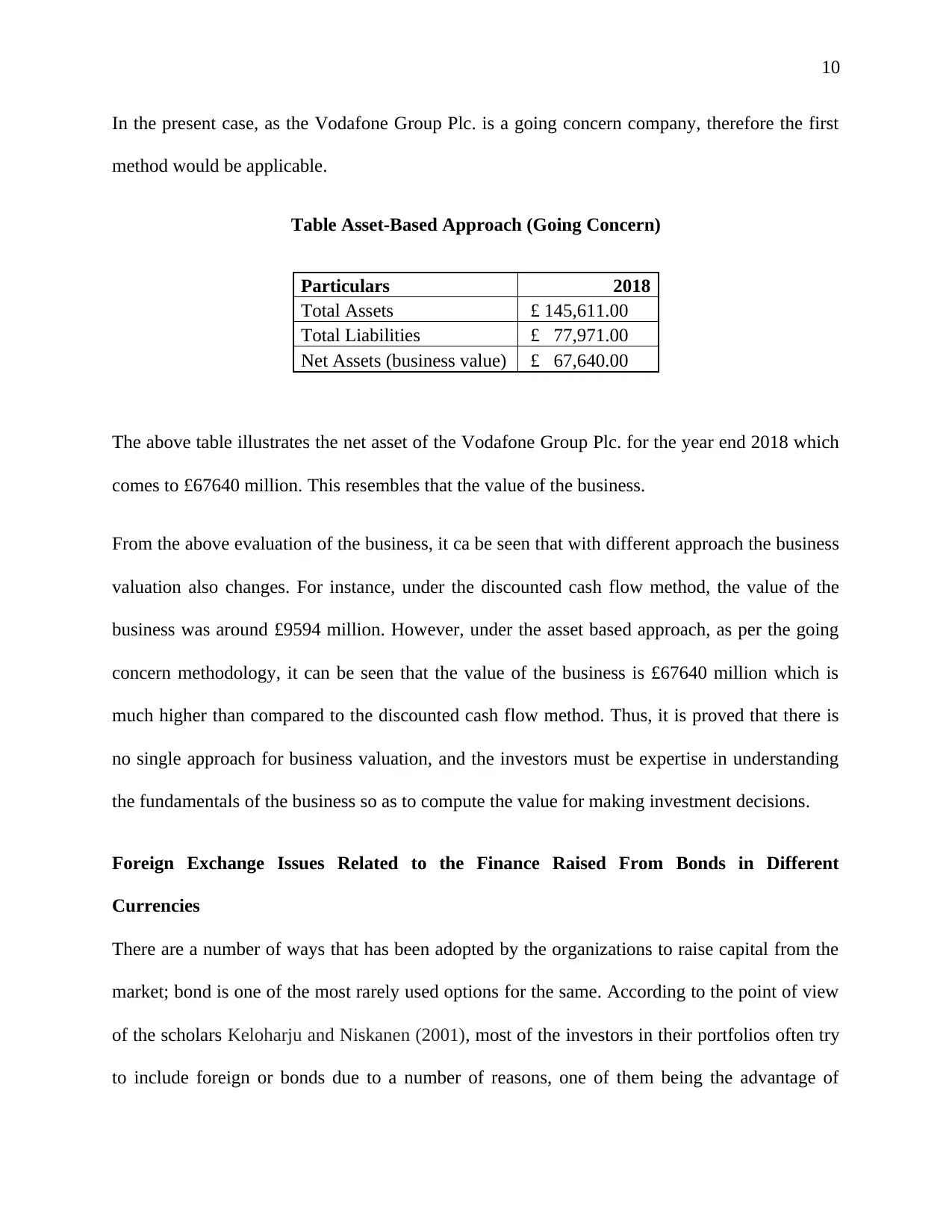
10
In the present case, as the Vodafone Group Plc. is a going concern company, therefore the first
method would be applicable.
Table Asset-Based Approach (Going Concern)
Particulars 2018
Total Assets £ 145,611.00
Total Liabilities £ 77,971.00
Net Assets (business value) £ 67,640.00
The above table illustrates the net asset of the Vodafone Group Plc. for the year end 2018 which
comes to £67640 million. This resembles that the value of the business.
From the above evaluation of the business, it ca be seen that with different approach the business
valuation also changes. For instance, under the discounted cash flow method, the value of the
business was around £9594 million. However, under the asset based approach, as per the going
concern methodology, it can be seen that the value of the business is £67640 million which is
much higher than compared to the discounted cash flow method. Thus, it is proved that there is
no single approach for business valuation, and the investors must be expertise in understanding
the fundamentals of the business so as to compute the value for making investment decisions.
Foreign Exchange Issues Related to the Finance Raised From Bonds in Different
Currencies
There are a number of ways that has been adopted by the organizations to raise capital from the
market; bond is one of the most rarely used options for the same. According to the point of view
of the scholars Keloharju and Niskanen (2001), most of the investors in their portfolios often try
to include foreign or bonds due to a number of reasons, one of them being the advantage of
In the present case, as the Vodafone Group Plc. is a going concern company, therefore the first
method would be applicable.
Table Asset-Based Approach (Going Concern)
Particulars 2018
Total Assets £ 145,611.00
Total Liabilities £ 77,971.00
Net Assets (business value) £ 67,640.00
The above table illustrates the net asset of the Vodafone Group Plc. for the year end 2018 which
comes to £67640 million. This resembles that the value of the business.
From the above evaluation of the business, it ca be seen that with different approach the business
valuation also changes. For instance, under the discounted cash flow method, the value of the
business was around £9594 million. However, under the asset based approach, as per the going
concern methodology, it can be seen that the value of the business is £67640 million which is
much higher than compared to the discounted cash flow method. Thus, it is proved that there is
no single approach for business valuation, and the investors must be expertise in understanding
the fundamentals of the business so as to compute the value for making investment decisions.
Foreign Exchange Issues Related to the Finance Raised From Bonds in Different
Currencies
There are a number of ways that has been adopted by the organizations to raise capital from the
market; bond is one of the most rarely used options for the same. According to the point of view
of the scholars Keloharju and Niskanen (2001), most of the investors in their portfolios often try
to include foreign or bonds due to a number of reasons, one of them being the advantage of
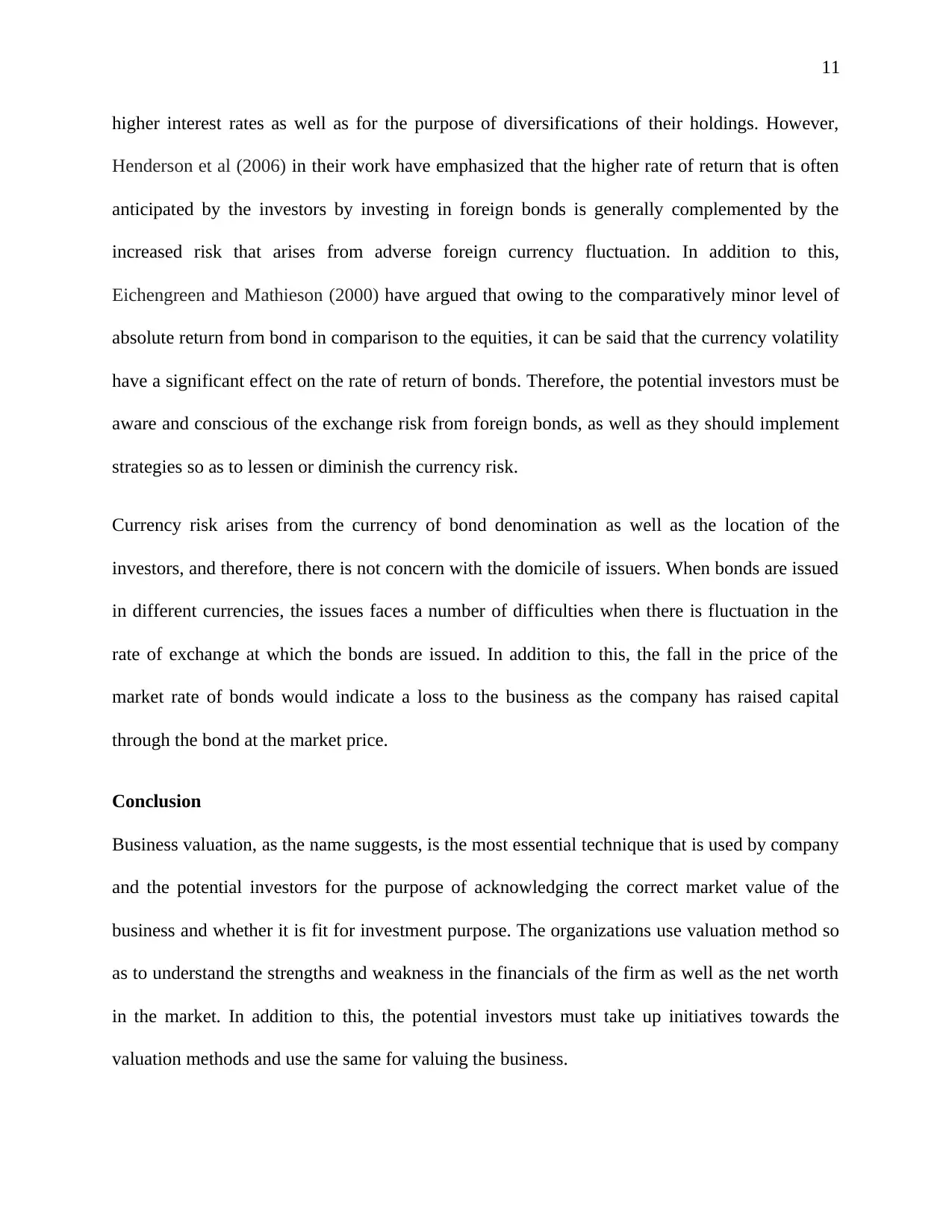
11
higher interest rates as well as for the purpose of diversifications of their holdings. However,
Henderson et al (2006) in their work have emphasized that the higher rate of return that is often
anticipated by the investors by investing in foreign bonds is generally complemented by the
increased risk that arises from adverse foreign currency fluctuation. In addition to this,
Eichengreen and Mathieson (2000) have argued that owing to the comparatively minor level of
absolute return from bond in comparison to the equities, it can be said that the currency volatility
have a significant effect on the rate of return of bonds. Therefore, the potential investors must be
aware and conscious of the exchange risk from foreign bonds, as well as they should implement
strategies so as to lessen or diminish the currency risk.
Currency risk arises from the currency of bond denomination as well as the location of the
investors, and therefore, there is not concern with the domicile of issuers. When bonds are issued
in different currencies, the issues faces a number of difficulties when there is fluctuation in the
rate of exchange at which the bonds are issued. In addition to this, the fall in the price of the
market rate of bonds would indicate a loss to the business as the company has raised capital
through the bond at the market price.
Conclusion
Business valuation, as the name suggests, is the most essential technique that is used by company
and the potential investors for the purpose of acknowledging the correct market value of the
business and whether it is fit for investment purpose. The organizations use valuation method so
as to understand the strengths and weakness in the financials of the firm as well as the net worth
in the market. In addition to this, the potential investors must take up initiatives towards the
valuation methods and use the same for valuing the business.
higher interest rates as well as for the purpose of diversifications of their holdings. However,
Henderson et al (2006) in their work have emphasized that the higher rate of return that is often
anticipated by the investors by investing in foreign bonds is generally complemented by the
increased risk that arises from adverse foreign currency fluctuation. In addition to this,
Eichengreen and Mathieson (2000) have argued that owing to the comparatively minor level of
absolute return from bond in comparison to the equities, it can be said that the currency volatility
have a significant effect on the rate of return of bonds. Therefore, the potential investors must be
aware and conscious of the exchange risk from foreign bonds, as well as they should implement
strategies so as to lessen or diminish the currency risk.
Currency risk arises from the currency of bond denomination as well as the location of the
investors, and therefore, there is not concern with the domicile of issuers. When bonds are issued
in different currencies, the issues faces a number of difficulties when there is fluctuation in the
rate of exchange at which the bonds are issued. In addition to this, the fall in the price of the
market rate of bonds would indicate a loss to the business as the company has raised capital
through the bond at the market price.
Conclusion
Business valuation, as the name suggests, is the most essential technique that is used by company
and the potential investors for the purpose of acknowledging the correct market value of the
business and whether it is fit for investment purpose. The organizations use valuation method so
as to understand the strengths and weakness in the financials of the firm as well as the net worth
in the market. In addition to this, the potential investors must take up initiatives towards the
valuation methods and use the same for valuing the business.
⊘ This is a preview!⊘
Do you want full access?
Subscribe today to unlock all pages.

Trusted by 1+ million students worldwide
1 out of 16
Related Documents
Your All-in-One AI-Powered Toolkit for Academic Success.
+13062052269
info@desklib.com
Available 24*7 on WhatsApp / Email
![[object Object]](/_next/static/media/star-bottom.7253800d.svg)
Unlock your academic potential
Copyright © 2020–2025 A2Z Services. All Rights Reserved. Developed and managed by ZUCOL.





